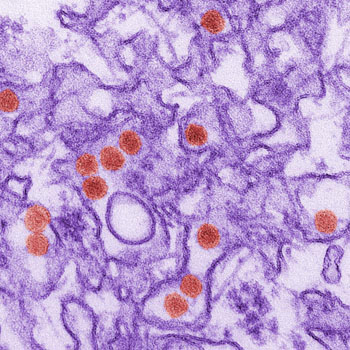Post-Infection Zika Virus Shed in Saliva and Semen
By LabMedica International staff writers
Posted on 19 Oct 2016
Results of a study of the mechanism of Zika virus infection in two primate models demonstrated that the virus spread rapidly into the nervous system of healthy animals and that shedding of the virus in saliva and semen underscored possible concern for additional neurological complications and non-mosquito-mediated transmission in humans.Posted on 19 Oct 2016
Infection with Zika virus has been associated with serious neurological complications and fetal abnormalities. However, the dynamics of viral infection, replication and shedding are poorly understood.

Image: Digitally colorized transmission electron micrograph (TEM) of Zika virus. Virus particles, colored red, are 40 nanometers in diameter, with an outer envelope, and an inner dense core (Photo courtesy of the CDC).
To obtain a better understanding of the mechanism that underlies Zika virus infection, investigators at Beth Israel Deaconess Medical Center (Boston, MA, USA) colleagues infected 36 rhesus and cynomolgus macaques with subcutaneous injections of strains of the Zika virus from Puerto Rico and Thailand. Over the next four weeks, the investigators analyzed blood, tissues, cerebrospinal fluid (CSF), and mucosal secretions for the presence of Zika virus RNA and monitored the animals' immune response during early infection.
They reported in the October 3, 2016, online edition of the journal Nature Medicine that viral RNA could be detected in blood plasma as early as one day after infection. Viral RNA was also detected in saliva, urine, CSF, and semen, but only transiently in vaginal secretions. Although viral RNA during primary infection was cleared from blood plasma and urine within 10 days, viral RNA was detectable in saliva and seminal fluids until the end of the study, three weeks after the disappearance of viral RNA from the blood. Zika RNA was also identified in tissues, including the brain and male and female reproductive tissues, during early and late stages of infection.
The control of primary Zika virus infection in the blood was correlated with rapid innate and adaptive immune responses. Re-infection of six animals 45 days after primary infection with a heterologous strain of the virus resulted in complete protection, which suggested that primary Zika virus infection elicited protective immunity.
“We found, initially, that the virus replicated very rapidly and was cleared from the blood in most animals within ten days,” said senior author Dr. James B. Whitney, assistant professor of medicine at Beth Israel Deaconess Medical Center. “Nevertheless, we observed viral shedding in other bodily fluids such as spinal fluid, saliva, urine, and semen up to three weeks after the initial infection was already cleared. Of particular concern, we saw extraordinarily high levels of Zika virus in the brain of some of the animals – the cerebellum, specifically – soon after infection. Only one in five adults have noticeable symptoms of infection. However, if our data translate to humans, there may be need for enhanced clinical vigilance for any persons presenting with unusual neurological symptoms, and they should be tested for Zika infection.”
“We found that male-to-female transmission might be easier, while female-to-male may be less likely,” said Dr. Whitney. “Nonetheless, the high levels of Zika we observed in the uterus underscore the danger to a developing fetus.”
Related Links:
Beth Israel Deaconess Medical Center













